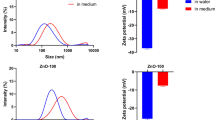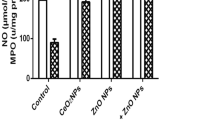Abstract
Oxidative renal tubular injuries and carcinogenesis induced by FeIII-nitrilotriacetate (NTA) and FeIII–ethylenediamine-N,N′-diacetate (EDDA) have been reported in rodent kidneys, but the identity of iron coordination structure essential for renal carcinogenesis, remains to be clarified. We compared renal tubular injuries caused by various low molecular weight aminocarboxylate type chelators with injuries due to NTA and EDDA. We found that FeIII-iminodiacetate (IDA), a novel iron-chelator, induced acute tubular injuries and lipid peroxidation to the same extent. We also prepared FeIII-IDA solutions at different pHs, and studied resultant oxidative injuries and physicochemical properties. The use of FeIII-IDA at pH 5.2, 6.2, and 7.2 resulted in renal tubular necrosis and apoptotic cell death, but neither tubular necrosis nor apoptosis was observed at pH 8.2. Spectrophotometric data suggested that FeIII-IDA had the same dimer structure from pH 6.2 to 7.2 as FeIII-NTA; but at a higher pH, iron polymerized and formed clusters. FeIII-IDA was crystallized, and this was confirmed by X-ray analysis and magnetic susceptibility measurements. These data indicated that FeIII-IDA possessed a linear μ-oxo bridged dinuclear iron (III) around neutral pH.
Similar content being viewed by others
Abbreviations
- TUNEL:
-
TdT-mediated dUTP nick end labeling
- TBARS:
-
thiobarbituric acid reactive substance
- ESR:
-
electron spin resonance
References
Awai M, Narasaki M, Yamanoi Y, Seno S. (1979) Induction of diabetes in animals by parenteal administration of ferric nitrilotriacetate. Am J Pathol 95: 663–674
Carl AB, Glenn JR, Ronald LM, Edward IS. (1995) Spectroscopic and Electronic Structure Studies of met-Hemerythrin Model Complexes: A Description of the Ferric-oxo Dimer Bond. Inorg. Chem. 34:688–7171
Donald M, Kurtz J. (1990) Oxo- and hydroxo-bridged diiron complexes: a chemical perspective on abiological unit. Chem. Rev. 90(4): 585–606
Engelmann MD, Babior RT, Hiatt T, Cheng IF. (2003) Variabirity of the Fenton reaction charactaristics of the EDTA, DTPA and citrate complexes of iron. Biometals 16: 519–527
Goodwin JF, Marphy B, Guillemette M. (1966) Direct measurement of serum iron and binding capacity. Clin Chem 12: 47
Halliwell B, Gtteridge JMC, Aruoma OI. (1987) The deoxyribose method: a simple ‘test-tube’ assay for determination of rate constants for reactions of hydroxyl radicals. Anal Biochem 165: 215–219
Hearth SL, Powell AK. (1992) The trapping of iron hydroxide units by the ligand (hida): Two new hydroxo(oxo)iron clusters containing 19 and 17 iron atoms. Angew Chem 31: 191–193
Hiroyasu M, Ozeki M, Kohda H, Eshizenya M, Tanaka T, Hiai H, Toyokuni S. (2002) Specific allelic loss of p16 (INK4A) tumor suppressor gene after weeks of iron-mediated oxidative damage during rat renal carcinogenesis. Am J Pathol 160: 419–424
Iqbal M, Sharma SD, Mizote A, Fujisawa M, Okada S. (2003) Differential role of hydrogen peroxide and organic hydroperoxides in augmenting ferric nitrilotriacetate (Fe-NTA)-mediated DNA damage: implications for carcinogenesis. Teratog Carcinog Mutagen l 1: 13–21
Kawabata T, Ma Y, Yamador I, Okada S. (1997) Iron-induced apoptosis in mouse renal proximal tubules after an injection of a renal carcinogen, iron-nitrilotriacetate Carcinogenesis 18: 1389–1389
Liu M, Okada S. (1994) Induction of free radicals and tumors in the kidneys of Wistar rats by ferric ethylenediamine-N,N′-diacetate. Carcinogenesis 15: 2817–2821
Liu M, Okada S, Kawabata T. (1991) Radical-promoting “free” iron level in the serum of rats treated with ferric nitrilotriacetate: comparison with other iron chelate complexes. Acta Med Okayama 45:401–408
Ma Y, Zhang D, Kawabata T, Kiriu T, Toyokuni S, Uchida K, Okada S. (1997) Copper and iron-induced oxidative damage in non-tumor bearing LEC rats. Pathol Int 47: 203–208
Ma Y, Kawabata T, Hamazaki S, Ogino T, Okada S. (1998) Sex differences in oxidative damage in ddY mouse kidney treated with a renal carcinogen, iron nitrilotriacetate. Carcinogenesis 19: 1983–1988
Mizote A, Hida A, Hosako M, Fujisawa M, Kamekawa M, Okada S. (2002) Effects of phlebotomy on the growth of ferric nitrilotriacetate-induced renal cell carcinoma. Acta Med Okayama 56: 199–204
Nishida Y, Ito S. (1995) Structures and reactivities of several iron (III) complexes in the presence of hydrogen peroxide: relevance to induction of tissue damage caused by iron (III) chelastes in rats. Polyhedron 14: 2301–2308
Nishida Y, Akamatu T. 1991 Preparation of iron (III) complex with nitrilotriacetic acid and origin of its unique reactivity. Chem Lett 1521–1524
Nishida Y. (1989) DNA cleavage by binuclear iron(III)-peroxide adducts. Inorg. chem Acta 163: 9–10
Nishida Y. (1999) Structure and function of free iron ion in biological system and their model compounds. Recent Res Devel Pure Applied Chem 3: 103–122
Ohkawa H, OhnishiN, Yagi K. (1979) Assay for lipid peroxides in animal tissues by thiobarbituric acid reaction. Anal Biochem 95: 351–358
Okada S. (2003) Prevention of free-radical mediated tissue damage and carcinogenesis induced by low-molecular-weight iron. Biometals 16:99–101
Okada S, Fukunaga Y, Hamazaki S, Yamada Y, Toyokuni S. (1991) Sex differences in the localization and severity of ferric nitrilotriacetate-induced lipid peroxidation in the mouse kidney. Acta Pathol Jpn 41: 221–6
Okada S, Minamiyama Y, Hamazaki S, Toyokuni S, Sotomatu A. (1993) Glutathione cycle dependency of ferric nitrilotriacetate-induced lipid peroxidation in mouse proximal renal tubules. Arch Biochem Biophys 301: 138–42
Okada, S. (1996) Iron-induced tissue damage and cancer: the role of reactive oxygen species-free radicals. Pathol Int 46: 311–32
Que L Jr, True AE. (1990) Dinuclear Iron- and Manganese-Oxo Sites. in Biology. Prog Inorg Chem 38: 97–200
Takahashi K, Nishida Y, Maeda Y. 1985 Crystal structure and magnetism of binuclear iron (III) complexes with a linear oxo-bridge. J Chem Soc Dalton Trans 2375–2380
Toyokuni S, Uchida K, Okamoto K. (1994) Formation of 4-hydroxy-2-nonenal-modified proteins in the renal proximal tubules of rats treated with a renal carcinogen, ferric nitrilotriacetate. Proc Nat Acad Sci USA 2616–2620
Toyokuni S, Sagripanti JL. (1996) Association between 8-hydroxy-2′-deoxyguanosine formation and DNA strand breaks mediated by copper and iron Free Radic. Biol Med 20: 859–864
Toyokuni S, Sagripanti JL. (1993) DNA single- and double-strand breaks produced by ferric nitrilotriacetate in relation to renal tubular carcinogenesis. Carcinogenesis 14: 223–227
Toyokuni S. (1996) Iron-induced carcinogenesis: The role of redox regulation Free Radic. Biol Med 20: 553–566
Wei RR, Richardson JP. (2001) Identification of an RNA-binding Site in the ATP binding domain of Escherichia coli Rho by H2O2/Fe-EDTA cleavage protection studies. J Biol Chem 276(30): 28380–28387
Yuan XM, Brunk UT, Olsson AG. (1995) Effects of iron- and hemoglobin-loaded human monocyte-derived macrophages on oxidation and uptake of LDL. Arterioscler Throm Vas Biol 15(9): 1345–1351
Zhang D, Okada S, Yu Y, Zheng P, Ymaguchi R, Kasai H. (1997) Vitamin E inhibits apoptosis, DNA modification, and cancer incidence induced by iron-mediated peroxidation in Wistar rat kidney. Cancer Res 57:2410–2414
Acknowledegments
We are very grateful to Prof. S. Yamazaki (Department of Fundamental Science, Okayama University of Science) for his helpful discussion, and Prof. T. Tokii (Department of Physical and Inorganic Chemistry, Saga University) for measuring magnetic susceptibility.
Author information
Authors and Affiliations
Corresponding author
Rights and permissions
About this article
Cite this article
Mizuno, R., Kawabata, T., Sutoh, Y. et al. Oxidative renal tubular injuries induced by aminocarboxylate-type iron (III) coordination compounds as candidate renal carcinogens. Biometals 19, 675–683 (2006). https://doi.org/10.1007/s10534-006-9004-4
Received:
Accepted:
Published:
Issue Date:
DOI: https://doi.org/10.1007/s10534-006-9004-4




